California Gold Rush
This original documentary showcases the historical significance California’s Gold Rush played in launching the largest mass migration in U.S. history and establishing California as the 31st state.
California Gold Rush

California gold rush nuggets
From Wikipedia, the free encyclopedia:
The first people to rush to the goldfields, beginning in the spring of 1848, were the residents of California themselves—primarily agriculturally oriented Americans and Europeans living in Northern California, along with Native Californians and some Californios (Spanish-speaking Californians; at the time, commonly referred to in English as simply ‘Californians’). These first miners tended to be families in which everyone helped in the effort. Women and children of all ethnicities were often found panning next to the men. Some enterprising families set up boarding houses to accommodate the influx of men; in such cases, the women often brought in steady income while their husbands searched for gold.
Word of the Gold Rush spread slowly at first. The earliest gold-seekers were people who lived near California or people who heard the news from ships on the fastest sailing routes from California. The first large group of Americans to arrive were several thousand Oregonians who came down the Siskiyou Trail. Next came people from the Sandwich Islands, and several thousand Latin Americans, including people from Mexico, from Peru and from as far away as Chile, both by ship and overland. By the end of 1848, some 6,000 Argonauts had come to California.
Only a small number (probably fewer than 500) traveled overland from the United States that year. Some of these “forty-eighters”, as the earliest gold-seekers were sometimes called, were able to collect large amounts of easily accessible gold—in some cases, thousands of dollars worth each day. Even ordinary prospectors averaged daily gold finds worth 10 to 15 times the daily wage of a laborer on the East Coast. A person could work for six months in the goldfields and find the equivalent of six years’ wages back home. Some hoped to get rich quick and return home, and others wished to start businesses in California.
Forty-niners came from Latin America, particularly from the Mexican mining districts near Sonora and Chile. Gold-seekers and merchants from Asia, primarily from China, began arriving in 1849, at first in modest numbers to Gum San (“Gold Mountain”), the name given to California in Chinese. The first immigrants from Europe, reeling from the effects of the Revolutions of 1848 and with a longer distance to travel, began arriving in late 1849, mostly from France, with some Germans, Italians, and Britons.
It is estimated that approximately 90,000 people arrived in California in 1849—about half by land and half by sea. Of these, perhaps 50,000 to 60,000 were Americans, and the rest were from other countries. By 1855, it is estimated at least 300,000 gold-seekers, merchants, and other immigrants had arrived in California from around the world. The largest group continued to be Americans, but there were tens of thousands each of Mexicans, Chinese, Britons, Australians, French, and Latin Americans, together with many smaller groups of miners, such as African Americans, Filipinos, Basques and Turks.
People from small villages in the hills near Genova, Italy were among the first to settle permanently in the Sierra Nevada foothills; they brought with them traditional agricultural skills, developed to survive cold winters. A modest number of miners of African ancestry (probably less than 4,000) had come from the Southern States, the Caribbean and Brazil.
A number of immigrants were from China. Several hundred Chinese arrived in California in 1849 and 1850, and in 1852 more than 20,000 landed in San Francisco.[67] Their distinctive dress and appearance was highly recognizable in the goldfields. Chinese miners suffered enormously, enduring violent racism from white miners who aimed their frustrations at foreigners. Further animosity toward the Chinese led to legislation such as the Chinese Exclusion Act and Foreign Miners Tax.
There were also women in the Gold Rush. However, their numbers were small. Of the 40,000 people who arrived by ship to the San Francisco Bay in 1849, only 700 were women (including those who were poor, wealthy, entrepreneurs, prostitutes, single, and married). They were of various ethnicities including Anglo-American, African-American, Hispanic, Native, European, Chinese, and Jewish.
The reasons they came varied: some came with their husbands, refusing to be left behind to fend for themselves, some came because their husbands sent for them, and others came (singles and widows) for the adventure and economic opportunities. On the trail many people died from accidents, cholera, fever, and myriad other causes, and many women became widows before even setting eyes on California. While in California, women became widows quite frequently due to mining accidents, disease, or mining disputes of their husbands. Life in the goldfields offered opportunities for women to break from their traditional work
California Gold Rush
#######
Be sure to view our Gold nuggets for sale.
View our Natural Silver specimens
Also see the most expensive type of gold nuggets, the Crystalline Gold Nuggets
Subscribe to our Youtube Arizona Gold Prospecting channel

0 Comments